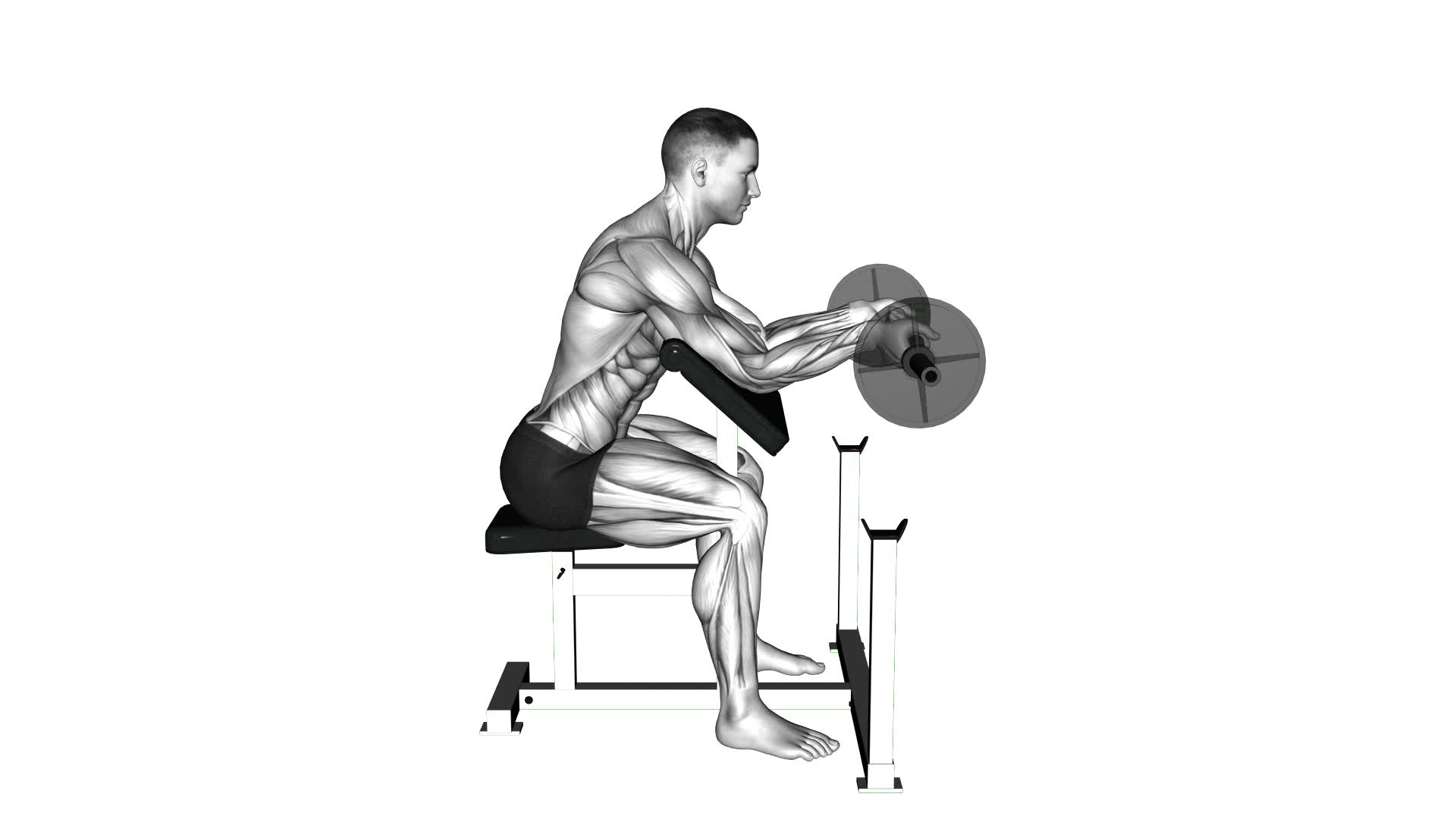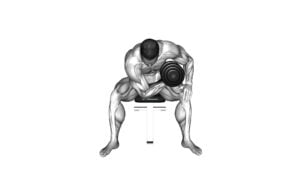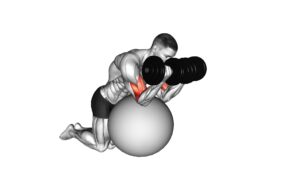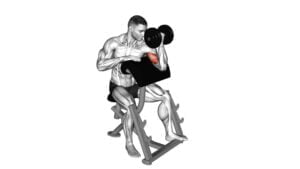Preacher Curl – Wrists (WRONG RIGHT) – Video Exercise Guide & Tips

Are you struggling with proper wrist alignment during preacher curls? Don't worry, we've got you covered!
Watch This Exercise Video
In this video exercise guide, we'll show you the right and wrong ways to position your wrists for maximum effectiveness and safety. Learn the importance of correct wrist placement and how to avoid common mistakes.
By maintaining proper form, you'll reap the benefits of stronger, more targeted bicep workouts. Keep reading for helpful tips and tricks to master this essential exercise.
Key Takeaways
- Proper wrist alignment is crucial for maximizing the effectiveness of preacher curls and minimizing the risk of wrist injuries.
- Maintaining a neutral wrist position throughout the exercise is essential, with the wrists in line with the forearms and palms facing upward.
- Gripping the barbell or dumbbell too tightly can hinder bicep contraction and limit range of motion.
- Consider using wrist wraps or braces for additional support and stability, especially for weak wrists or previous wrist injuries.
Importance of Proper Wrist Alignment
To maximize the effectiveness of your preacher curl exercise, it's crucial to maintain proper wrist alignment throughout the movement. This is especially important because common wrist injuries can occur if your wrists aren't properly aligned. When performing the preacher curl, it's essential to keep your wrists in a neutral position, neither flexed nor extended. This alignment helps distribute the weight evenly and minimizes strain on the wrist joints.
To strengthen your wrists and prevent injuries, incorporating specific exercises into your routine can be beneficial. Wrist curls are a popular choice, where you hold a dumbbell with an underhand grip and curl your wrists upwards and downwards. This exercise targets the forearm muscles, which play a significant role in wrist stability.
Another exercise is the wrist extension, where you hold a dumbbell with an overhand grip and extend your wrists upwards. This exercise targets the extensor muscles, which are responsible for wrist extension.
Common Mistakes With Wrist Placement
Improper wrist placement can lead to common mistakes during the preacher curl exercise. To avoid injuries and maximize the effectiveness of your workout, it's crucial to pay attention to your wrist alignment.
One common mistake is allowing your wrists to bend backward, which puts excessive strain on the joint and increases the risk of injury. This can happen when you use too much weight or have poor form.
Another mistake to avoid is gripping the barbell or dumbbell too tightly. While it may feel secure, this can actually limit your range of motion and hinder the full contraction of your biceps.
Additionally, keeping your wrists too flexed or extended during the exercise can also lead to discomfort and decreased performance.
To prevent these mistakes, make sure to maintain a neutral wrist position throughout the exercise, with your palms facing upward and wrists in line with your forearms.
Correct Wrist Positioning for Preacher Curls
To achieve proper form and prevent injuries during preacher curls, it's important that you maintain correct wrist positioning. Proper wrist alignment not only helps in avoiding wrist pain but also allows for better muscle activation and overall effectiveness of the exercise. Here are some tips to ensure proper positioning:
- Keep your wrists straight: Avoid bending your wrists excessively during the exercise. Keep them in a neutral, straight position to minimize strain on the joints.
- Maintain a firm grip: Grip the barbell or dumbbell tightly, ensuring that it's centered in your palms. This helps in distributing the weight evenly and provides stability to your wrists.
- Avoid excessive flexion or extension: While performing preacher curls, make sure your wrists don't excessively flex (bend downwards) or extend (bend upwards). Maintain a stable, controlled movement.
- Consider using wrist wraps: If you have weak wrists or experience discomfort during preacher curls, consider using wrist wraps. These provide additional support and stability, reducing the risk of injury.
Benefits of Proper Wrist Alignment
You can maximize your workout results by maintaining proper wrist alignment during preacher curls. The benefits of proper wrist alignment can't be overstated.
Firstly, it helps to prevent injury. When your wrists are properly aligned, the stress is evenly distributed, reducing the risk of strains or sprains. This is particularly important when using heavy weights or performing high-intensity exercises.
Secondly, proper wrist alignment allows for better muscle activation. When your wrists are in the correct position, you engage the targeted muscles more effectively. This means you can fully reap the benefits of your preacher curl exercise, leading to increased strength and muscle growth.
In addition, maintaining proper wrist alignment enhances your overall form and technique. This ensures that you're performing the exercise correctly, targeting the intended muscle group, and avoiding unnecessary strain on other joints. It also helps to optimize your range of motion and improve your lifting efficiency.
Lastly, proper wrist alignment promotes better grip strength. By aligning your wrists in a neutral position, you can generate more power and stability through your grip, allowing you to lift heavier weights and perform more repetitions.
Tips for Maintaining Correct Wrist Form
Maintain correct wrist form during preacher curls by focusing on your wrist alignment. Proper wrist form is crucial to prevent common wrist injuries and maximize the effectiveness of your workout. Here are some tips to help you maintain correct wrist form:
- Straight Wrists: Keep your wrists straight throughout the movement. Avoid bending or flexing them, as this can put unnecessary strain on the joints.
- Neutral Position: Maintain a neutral position with your wrists. They should be in line with your forearms, not bent forward or backward.
- Grip Strength: Improve your grip strength with wrist exercises for strength. This will help you maintain proper wrist alignment and prevent any unwanted movements.
- Wrist Support: Consider using wrist wraps or braces for extra support, especially if you have weak wrists or a history of wrist injuries.
Frequently Asked Questions
How Much Weight Should I Use for Preacher Curls?
When doing preacher curls, it's important to use the proper form. Start with a weight that challenges you, but allows you to maintain good technique. Don't sacrifice form for heavy weights.
Varying your grip during preacher curls can provide different benefits. A narrow grip targets the outer part of your biceps, while a wider grip targets the inner part. Experiment with different grips to work all areas of your biceps and maximize your gains.
Can I Do Preacher Curls Without a Preacher Curl Bench?
Yes, you can still do preacher curls without a preacher curl bench. There are alternative exercises that can target the same muscles as preacher curls.
However, using a preacher curl bench offers some specific benefits. It provides stability and isolates the biceps, allowing for a more focused workout. Additionally, it helps to prevent cheating or using momentum to lift the weight.
Is It Necessary to Wear Wrist Wraps While Performing Preacher Curls?
When performing preacher curls, you might wonder if wearing wrist wraps is necessary.
The benefits of using wrist wraps during preacher curls include providing extra support and stability to your wrists, reducing the risk of injury.
Additionally, they can help maintain proper form and prevent common mistakes such as wrist flexion or excessive strain on the tendons.
Are Preacher Curls Effective for Building Biceps Size and Strength?
Preacher curls can be highly effective for building biceps size and strength. To ensure proper form, keep your back straight, elbows stationary, and focus on contracting your biceps throughout the movement.
There are also variations you can try to maximize bicep growth, such as using dumbbells instead of a barbell or incorporating different grip widths.
Remember to start with a weight that challenges you but allows for proper form, gradually increasing as you get stronger.
Can I Perform Preacher Curls Using Dumbbells Instead of a Barbell?
Yes, you can perform preacher curls using dumbbells instead of a barbell. This variation is a great way to switch up your routine and target your biceps from a different angle.
Preacher curls are effective for building biceps size and strength, and using dumbbells adds an additional challenge to the exercise.
Benefits of preacher curls include isolating the biceps, improving muscle definition, and enhancing overall arm strength.
Conclusion
In conclusion, maintaining proper wrist alignment during preacher curls is crucial for maximizing the effectiveness of the exercise and preventing injury. By avoiding common mistakes and positioning your wrists correctly, you can reap the benefits of this exercise, such as increased strength and muscle development in the biceps.
Remember to focus on maintaining correct wrist form and consult a fitness professional if you need further guidance.

Author
Years ago, the spark of my life’s passion ignited in my mind the moment I stepped into the local gym for the first time. The inaugural bead of perspiration, the initial endeavor, the very first surge of endorphins, and a sense of pride that washed over me post-workout marked the beginning of my deep-seated interest in strength sports, fitness, and sports nutrition. This very curiosity blossomed rapidly into a profound fascination, propelling me to earn a Master’s degree in Physical Education from the Academy of Physical Education in Krakow, followed by a Sports Manager diploma from the Jagiellonian University. My journey of growth led me to gain more specialized qualifications, such as being a certified personal trainer with a focus on sports dietetics, a lifeguard, and an instructor for wellness and corrective gymnastics. Theoretical knowledge paired seamlessly with practical experience, reinforcing my belief that the transformation of individuals under my guidance was also a reflection of my personal growth. This belief holds true even today. Each day, I strive to push the boundaries and explore new realms. These realms gently elevate me to greater heights. The unique combination of passion for my field and the continuous quest for growth fuels my drive to break new ground.







